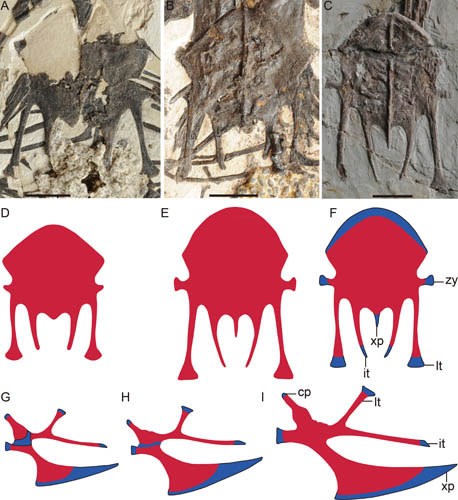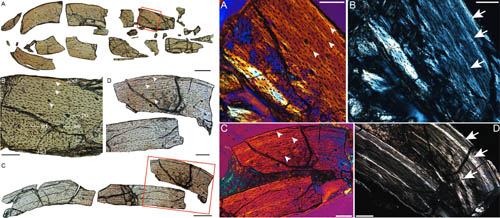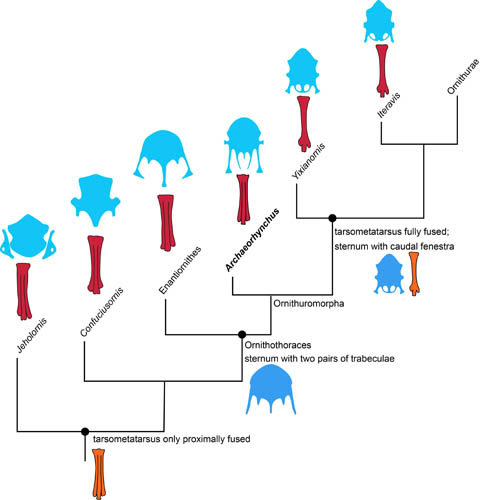
Most living birds characteristically grow rapidly and reach adult size within a year. Nevertheless, little is known about how such an advanced developmental strategy evolved despite many discoveries of early fossil birds. In a paper published online Feburary 3 in the Journal of Systematic Palaeontology, Drs. WANG Min and ZHOU Zhonghe, Institute of Vertebrate Paleontology and Paleoanthropology (IVPP), Chinese Academy of Sciences, described a new adult specimen of Archaeorhynchus spathula, the basal-most taxon of Ornithuromorpha, and compared the bone microstructure of this taxon to other Mesozoic and living birds. Their study reveals ontogenetic variations in early birds, providing important information regarding ontogeny for early ornithuromorphs.
Ornithuromorpha is the most inclusive clade containing extant birds but not the Mesozoic Enantiornithes. The previous known morphology of Archaeorhynchus is based on three juvenile or subadult specimens. This new specimen was unearthed from the Early Cretaceous Yixian Formation at Jiangzhangzi Village, Linyuan City, in Liaoning Province, north-eastern China. It is an almost fully articulated skeleton preserved in a single nearly intact slab.
Bone histology and skeletal fusion indicate the new specimen is an adult individual. Compared with the known juveniles or subadults of Archaeorhynchus, it provides a rare chance to address how morphologies change from juvenile to adult stages and also how fusion proceeds in certain compound bones, as few specimens with different ontogenetic stages are ever discovered.
Histological analysis of Archaeorhynchus spathula reveals that the cortex is composed of parallel-fibred bone with three lines of arrested growth, indicative of slow and annually interrupted growth for this species. Such bone histology is significantly different from that of other known basal ornithuromorphs, but resembles that of enantiornithines, researchers suggest protracted slow growth in the common ancestor of Ornithuromorpha and Enantiornithes.
The fusion sequence of the tarsometatarsus between Enantiornithes and Ornithuromorpha had long been hypothesized to be different. In living birds, metatarsals IIIV start to fuse at the mid-shaft and fusion proceeds proximally and distally; the proximal fusion with the distal tarsals completes relatively late. By contrast, the tarsometatarsus is only fused proximally in enantiornithines and more basal taxa. The fusion sequence of the tarsometatarsus between Enantiornithes and Ornithuromorpha had been regarded as indicative that enantiornithines are not close relatives of ornithuromorphs. Due to a lack of fossils recording early ontogenetic stages, little is known about the development of the tarsometatarsus in basal ornithuromorphs, making this hypothesis impossible to test.
“In the light of four specimens capturing different ontogenetic stages for Archaeorhynchus, the fusion sequence of the tarsometatarsus in Archaeorhynchus is similar to that of enantiornithines, and that the proximal-early fusion in tarsometatarsus represents a primitive trait for basal birds”, said lead author WANG Min, “Most morphological features associated with the adult Archaeorhynchus have already appeared in the subadult stage, with distinct changes in sternal morphology. Our findings also shed light on ontogenetic variation of sternal morphology, which highlights the importance of ontogeny in the taxonomic and phylogenetic study of early birds”.
During their contemporaneous 65-million-year history, ornithuromorphs and enantiornithines evolved along different pathways, the former evolving a modern bird-like growth pattern and the latter retaining the protracted slow growth pattern. Enantiornithes perished with other non-avian dinosaurs in the K-Pg mass extinction, but relicts of ornithuromorphs persisted through this global catastrophe and later flourished in the Paleocene. “The different growth strategies may have represented one of many possible factors for the different fates of enantiornithines and ornithuromorphs. Rapid and sustained growth enables the individual to reach adult size within a short time, and adult size and enhanced locomotive capability are advantageous in circumstances of predator defense and escaping from a fatal environment”, said the project leader ZHOU Zhonghe.
This research was founded by the National Natural Science Foundation of China, the Youth Innovation Promotion Association (CAS), the State Key Laboratory of Palaeobiology and Stratigraphy (Nanjing Institute of Geology and Palaeontology, CAS) and the National Basic Research Program of China 973 Program.

Fig.1 Ontogenetic variation of sternal morphology. Blue indicates cartilage and red indicates bone. (Image by WANG Min)

Fig.2 Tarsometatarsus of basal birds and its fusion sequence in living birds. Blue indicates cartilage and red indicates bone. (Image by WANG Min)

Fig.3 Bone histology of Archaeorhynchus spathula. (Image by WANG Min)

Fig.4 Distribution of sternum and tarsometatarsus morphologies in basal birds. (Image by WANG Min)

86-10-68597521 (day)
86-10-68597289 (night)

86-10-68511095 (day)
86-10-68512458 (night)

cas_en@cas.cn

52 Sanlihe Rd., Xicheng District,
Beijing, China (100864)

